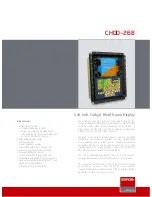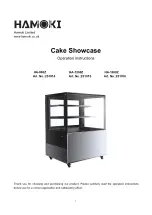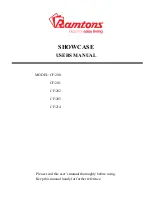
G SERIES PILOT’S GUIDE .
INSIGHT
INSTRUMENT CORPORATION BOX 122, FORT ERIE, ONTARIO, L2A 5M6
26
Leaning in Cruise
The G3-4 is ready for leaning without any user action. If necessary press and hold the bottom button to clear any peak
temperature boxes. As the pilot leans the engine the bars will rise then fall leaving a peak temperature box behind. This box
will show the distance in degrees from peak and whether the mixture is rich or lean of peak. Temperatures preceded by an
‘L’ eg ‘L47’ are lean of peak while those prefixed with an ‘R’ are rich.
In addition to the letter lean setting are displayed in white and rich setting in cyan.
The user may set a threshold which is used to trigger the box from being hollow to being solid filled.
Should the user wish to operate say 25 degrees lean he/she may set the threshold and lean until all the lean boxes are
displayed as filled. This is a simple and easy way to lean correctly and precisely.
Leaning Normally Aspirated Engines in Climb
Most normally aspirated aircraft benefit from mixture leaning during climb with less plug fouling, better engine performance,
smoother operation and increased economy. The full throttle, full rich mixture setting is designed to provide an enriched fuel
flow for proper engine cooling during takeoff at sea level on a standard day. As the aircraft climbs, the air density decreases
causing an effective enrichment of the mixture, eventually robbing the engine of power.
Leaning in climb is advisable for best performance and will result in a cleaner engine and easier cruise leaning later on.
After safely clearing the field, observe the location of the tops of the bars on the G3-4.
As you ascend, the effective mixture enrichment that results from the decreasing air density causes the EGT reading to
fall. Observe one column as a reference. When the reading drops, lean the mixture until the reading goes up, restoring the
bar. Repeat this procedure each time the EGT reading drops due to ascent into less dense air to ensure that highest EGT.
Aircraft equipped with fuel flow gauges may have altitude reference marks to guide leaning during climb.
This procedure for leaning in climb does not apply to turbocharged engines which do not experience the same air density
variations due to altitude.
Leaning the Engine in Cruise without Lean Mode
There are occasions when the pilot may wish to lean manually. It is informative on the first G3-4 training flight to lean the
engine without Lean Mode to get a feel for the instrument. As you lean, the bars will rise, reach a maximum, and then fall at
the onset of engine roughness. If you lean too far the engine will stop. Short flights in high traffic density Terminal Control
Airspace (Class B Airspace) demand maximum pilot attention to traffic avoidance.
When busy, the pilot may lean quickly by watching the bars rise and stopping when they are still below the normal average
indication. This procedure will be within a gallon or two per hour of the optimum mixture setting, and can be used as a tem-
porary measure until time permits using the complete leaning procedure described below.
Leaning by Turbine Inlet Temperature
Some turbocharged engines are designed to be leaned by reference to Turbine Inlet Temperature (TIT).
This may imply that the TIT is the first temperature to reach redline and is the overall limiting factor in the leaning procedure.
Some manufacturers may put a limit on the TIT to increase detonation margins. In general, turbochargers are very much
alike and most manufacturers specify a redline of 1650° F. Some operate as high 1750° F.
Because indicated temperature is largely dependent on probe placement and exhaust flow, it may not be the same as that
experienced by the turbo.
Aircraft manufacturers have very likely taken this into account when deciding on the official TIT redline.
Leaning Restrictions
Some aircraft have restrictions on leaning that must be observed. The recommendations of this manual are not intended to
supersede any specific requirements for engine operation as stated by the aircraft or engine manufacturer.
The pilot should consult the Pilot’s Operating Handbook and follow the manufacturer’s recommendations.
These restrictions typically, (but not exclusively) apply to aircraft with marginal cooling airflow at high altitude or high angles
of attack or turbocharged engines where concern over turbine inlet temperature, compressor discharge temperature, deto-
nation margin, or cylinder head temperature must dictate mixture settings.





































